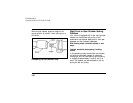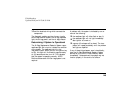
147
WARNING
Ifyouareclosetoaninflatingairbag,
itcouldseriouslyinjureyou.Position
yourseatsuchthatitisasfarback
fromthesteeringwheelaspossiblebut
stillallowsyoutoproperlycontrolthe
vehicle.
ChildrenandAirBags
NOTE : Fo r additiona l importan t safet yinformation
o n th e prope r us e o f sea t belts , chil dseats , and
infan t seats , pleas e rea d th e entir e Safet yRestraints
chapte r i n thi s owne r guide.
WARNING
Childrenshouldalwaysweartheir
safetybelts.Failuretofollowthese
instructionsmayincreasetheriskof
personalinjuryintheeventofa
collision.
WARNING
Rear-facingchildseatsorinfantcarriers
shouldneverbeplacedinthefront
seats.
HowDoestheAirBagSupplemental
RestraintSystemWork?
Th e Ai r Ba g Supplementa l Restrain t Syste mis
designe dt o activat e whe n th e vehicl e i s i n a
collisio n simila r t o hittin g a fixe d barrie r hea d o n at
8-1 4 mp h (13-2 3 km/h) . Th e fac t tha t th e ai r bags
di dno t inflat e i n a collisio n doe s no t mea n that
somethin g i s wron g wit h th e system . Rather , it
mean s th e force s wer e no t o f th e typ e sufficien t to
caus e activation.
I f th e vehicl e i s i n a moderat e o r sever e frontal
collision , th e syste mi s activate dan d th e ai r bags
inflat e rapidly . Afte r th e ai r ba g inflates , i t will
quickl ydeflate . Afte r th e ai r ba g deployment , you
ma ynotic e a smoke-like , powder yresidu e o r smell
File:06fnss8.ex
Update:Wed Jun 19 15:04:39 1996


















